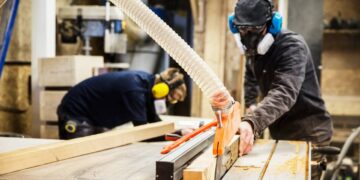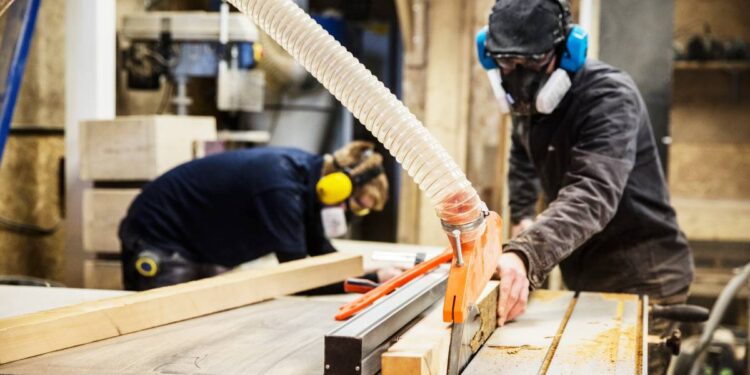When it comes to woodwork—whether building a home, renovating, or fitting out a commercial space—many people often use the terms carpentry and joinery interchangeably. While the two trades are closely related and sometimes overlap, there are distinct differences between them in terms of skills, work environments, and the types of projects they handle.
Understanding these differences can help you choose the right professional for your project, save time and money, and ensure the final result is exactly as you envisioned.
The Core Difference Between Carpentry and Joinery
At its simplest, carpentry involves working with wood on-site, while joinery involves crafting wooden components in a workshop.
-
Joinery focuses on creating the parts.
-
Carpentry focuses on assembling and installing them.
Here’s a breakdown to make it clearer:
| Aspect | Carpentry | Joinery |
|---|---|---|
| Work Location | Mostly on-site | Mostly in workshops |
| Primary Work | Installation, fitting, framing, structural work | Building detailed wooden components like doors, windows, staircases, cabinets |
| Tools Used | Power tools, saws, hammers, drills | Precision tools, saws, clamps, and sanding machines |
| Project Examples | Framing walls, fitting skirting boards, building decking or roofing | Making furniture, door frames, window sashes, kitchen cabinets |
| Focus | Functionality and assembly | Craftsmanship and detail |
What Does a Carpenter Do?
A carpenter is a skilled tradesperson who constructs, installs, and repairs wooden frameworks and structures. Their work often forms the backbone of a building, such as walls, floors, roofs, and staircases.
Typical Tasks of a Carpenter Include:
-
Installing door frames, skirting boards, and architraves
-
Constructing decking, pergolas, and timber framing
-
Building or repairing roofing structures
-
Assembling and fitting wooden furniture or cabinets made by joiners
-
Working on-site to ensure structural integrity and precision
Carpenters work with rough timber that needs to be shaped, cut, and assembled to fit a specific structure. Their work is highly practical and often involves handling larger pieces of wood that require heavy-duty tools and on-site problem-solving.
What Does a Joiner Do?
A joiner, on the other hand, is often considered the craftsperson behind the woodwork. Joiners create the fine wooden components that carpenters later fit into place.
Their work is usually completed in a controlled workshop environment where precision and craftsmanship are key.
Typical Tasks of a Joiner Include:
-
Crafting custom furniture such as wardrobes, cabinets, and tables
-
Building staircases, doors, window frames, and balustrades
-
Creating decorative mouldings, shelving, or built-in units
-
Designing and producing intricate wood joints for strength and aesthetics
Joiners often use advanced woodworking machinery to ensure precision, smooth finishes, and perfect fittings. Once their components are made, they are transported to the site for installation—often by carpenters.
The Overlap Between Carpentry and Joinery
Although carpentry and joinery are distinct trades, there’s a significant amount of overlap—especially in smaller projects or in modern construction.
For instance:
-
A carpenter may make and install a custom staircase.
-
A joiner may also fit cabinets or perform minor on-site adjustments.
In rural areas or smaller towns, you’ll often find professionals who offer both carpentry and joinery services, commonly referred to as carpenter-joiners. They possess a wide range of skills, enabling them to handle everything from making to fitting.
However, in large-scale projects—such as commercial fit-outs or architectural builds—the distinction is more pronounced. Each specialist focuses on their area to ensure precision, quality, and compliance with building codes.
Can You Use Carpentry and Joinery Services Interchangeably?
The short answer: sometimes—but not always.
If you need a wooden structure built, such as a roof frame, deck, or partition wall, you’ll need a carpenter.
If you need a wooden component built or designed, such as a custom door, cabinet, or staircase, you’ll need a joiner.
Let’s look at some examples to help clarify when to call each professional:
When to Hire a Carpenter
-
Building and installing timber frames for a new house
-
Constructing outdoor decks, fences, or pergolas
-
Fitting skirting boards, door frames, or window frames
-
Installing joinery pieces made in a workshop
When to Hire a Joiner
-
Designing and making bespoke kitchen cabinets or wardrobes
-
Crafting timber doors, windows, or staircases
-
Building custom wooden furniture or decorative elements
-
Creating complex wood joints that require high precision
When You Might Need Both
Many projects require both trades to achieve the desired outcome. For example:
-
A joiner may build a staircase in a workshop.
-
A carpenter then installs that staircase on-site.
In some cases, the same tradesperson may handle both roles, but for larger or more intricate jobs, it’s best to work with both to ensure a seamless result.
Training and Qualifications
Both carpentry and joinery require extensive hands-on training and apprenticeships. In Australia, tradespeople typically complete a Certificate III in Carpentry or Joinery (or a combined qualification) through TAFE or a registered training organisation.
This involves:
-
Learning to read and interpret building plans
-
Understanding Australian building codes and standards
-
Gaining experience with tools, machinery, and materials
-
Working under supervision to develop practical skills
After completing their qualifications, many go on to specialise in areas such as furniture making, shopfitting, or restoration work.
Tools and Techniques
While both trades work with wood, their tools and methods differ.
Carpentry Tools:
-
Circular saws, jigsaws, drills, and nail guns
-
Hammers, chisels, and levels
-
Measuring tapes and squares
Joinery Tools:
-
Planers, routers, and sanders
-
Mortisers and tenon machines
-
Precision measuring instruments and clamps
Joiners usually work with more delicate, fine-tuned machinery, whereas carpenters handle heavier, site-oriented tools.
Quality, Precision, and Craftsmanship
Another key difference lies in precision.
Joinery demands extremely fine measurements—often down to the millimetre—because each piece must fit perfectly within another. Carpenters, while also precise, focus on ensuring the overall structure is sound, level, and safe.
In short:
-
Joinery = precision and aesthetics
-
Carpentry = structure and stability
Both roles are crucial. Without joiners, we wouldn’t have beautiful, custom wooden features. Without carpenters, we wouldn’t have the stable framework to hold them in place.
Cost Differences
Costs depend on the project’s complexity, materials, and location.
Generally speaking:
-
Joinery tends to be more expensive per hour because of the precision, machinery, and custom work involved.
-
Carpentry can be more affordable for structural or installation jobs, but costs can rise with intricate detailing or on-site challenges.
Hiring the right professional for the job helps avoid costly mistakes or rework. For instance, asking a carpenter to produce custom cabinetry without the right tools may lead to imperfections that require a joiner to fix later.
Choosing the Right Professional for Your Project
Here are some tips to ensure you hire the right person:
-
Define Your Project Clearly:
Write down what you need—structural work, furniture, fittings, or installation. -
Check Their Portfolio:
Review past projects to see whether they specialise in the type of work you need. -
Ask About Qualifications:
Ensure they are licensed and trained under Australian standards. -
Request Quotes from Both:
For larger projects, compare quotes from both carpenters and joiners to determine the best value and skill match. -
Consider Integrated Services:
Some companies offer both carpentry and joinery under one roof, which ensures seamless coordination from workshop to installation.
The Bottom Line
Carpentry and joinery are two sides of the same coin—each essential to the creation of high-quality woodwork. While their roles often overlap, they serve distinct purposes:
-
Carpentry focuses on building and installation.
-
Joinery focuses on creating detailed wooden components.
You can sometimes use the services interchangeably, especially for smaller projects or when hiring a tradesperson who’s skilled in both areas. However, for large, complex, or custom work, it’s best to engage specialists in each trade to achieve the highest level of quality, craftsmanship, and safety.
By understanding the distinction between carpentry and joinery, you’ll be better equipped to plan your project, communicate clearly with professionals, and ensure that every timber element—from frame to finish—is done right.
If you’re looking for professional carpentry and joinery services that combine craftsmanship, reliability, and attention to detail, contact HR and R. Their team of experienced tradespeople delivers top-quality woodwork—from custom joinery pieces to complete carpentry installations—tailored to your project needs.
















































